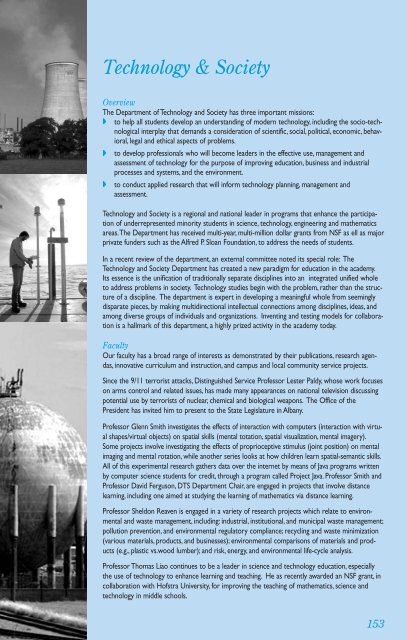SPIR - Stony Brook University
SPIR - Stony Brook University
SPIR - Stony Brook University
You also want an ePaper? Increase the reach of your titles
YUMPU automatically turns print PDFs into web optimized ePapers that Google loves.
Technology & Society<br />
Overview<br />
The Department of Technology and Society has three important missions:<br />
w to help all students develop an understanding of modern technology, including the socio-technological<br />
interplay that demands a consideration of scientific, social, political, economic, behavioral,<br />
legal and ethical aspects of problems.<br />
w to develop professionals who will become leaders in the effective use, management and<br />
assessment of technology for the purpose of improving education, business and industrial<br />
processes and systems, and the environment.<br />
w to conduct applied research that will inform technology planning, management and<br />
assessment.<br />
Technology and Society is a regional and national leader in programs that enhance the participation<br />
of underrepresented minority students in science, technology, engineering and mathematics<br />
areas.The Department has received multi-year, multi-million dollar grants from NSF as ell as major<br />
private funders such as the Alfred P. Sloan Foundation, to address the needs of students.<br />
In a recent review of the department, an external committee noted its special role: The<br />
Technology and Society Department has created a new paradigm for education in the academy.<br />
Its essence is the unification of traditionally separate disciplines into an integrated unified whole<br />
to address problems in society. Technology studies begin with the problem, rather than the structure<br />
of a discipline. The department is expert in developing a meaningful whole from seemingly<br />
disparate pieces, by making multidirectional intellectual connections among disciplines, ideas, and<br />
among diverse groups of individuals and organizations. Inventing and testing models for collaboration<br />
is a hallmark of this department, a highly prized activity in the academy today.<br />
Faculty<br />
Our faculty has a broad range of interests as demonstrated by their publications, research agendas,<br />
innovative curriculum and instruction, and campus and local community service projects.<br />
Since the 9/11 terrorist attacks, Distinguished Service Professor Lester Paldy, whose work focuses<br />
on arms control and related issues, has made many appearances on national television discussing<br />
potential use by terrorists of nuclear, chemical and biological weapons. The Office of the<br />
President has invited him to present to the State Legislature in Albany.<br />
Professor Glenn Smith investigates the effects of interaction with computers (interaction with virtual<br />
shapes/virtual objects) on spatial skills (mental totation, spatial visualization, mental imagery).<br />
Some projects involve investigating the effects of proprioceptive stimulus (joint position) on mental<br />
imaging and mental rotation, while another series looks at how children learn spatial-semantic skills.<br />
All of this experimental research gathers data over the internet by means of Java programs written<br />
by computer science students for credit, through a program called Project Java. Professor Smith and<br />
Professor David Ferguson, DTS Department Chair, are engaged in projects that involve distance<br />
learning, including one aimed at studying the learning of mathematics via distance learning.<br />
Professor Sheldon Reaven is engaged in a variety of research projects which relate to environmental<br />
and waste management, including: industrial, institutional, and municipal waste management;<br />
pollution prevention, and environmental regulatory compliance; recycling and waste minimization<br />
(various materials, products, and businesses); environmental comparisons of materials and products<br />
(e.g., plastic vs.wood lumber); and risk, energy, and environmental life-cycle analysis.<br />
Professor Thomas Liao continues to be a leader in science and technology education, especially<br />
the use of technology to enhance learning and teaching. He as recently awarded an NSF grant, in<br />
collaboration with Hofstra <strong>University</strong>, for improving the teaching of mathematics, science and<br />
technology in middle schools.<br />
153


